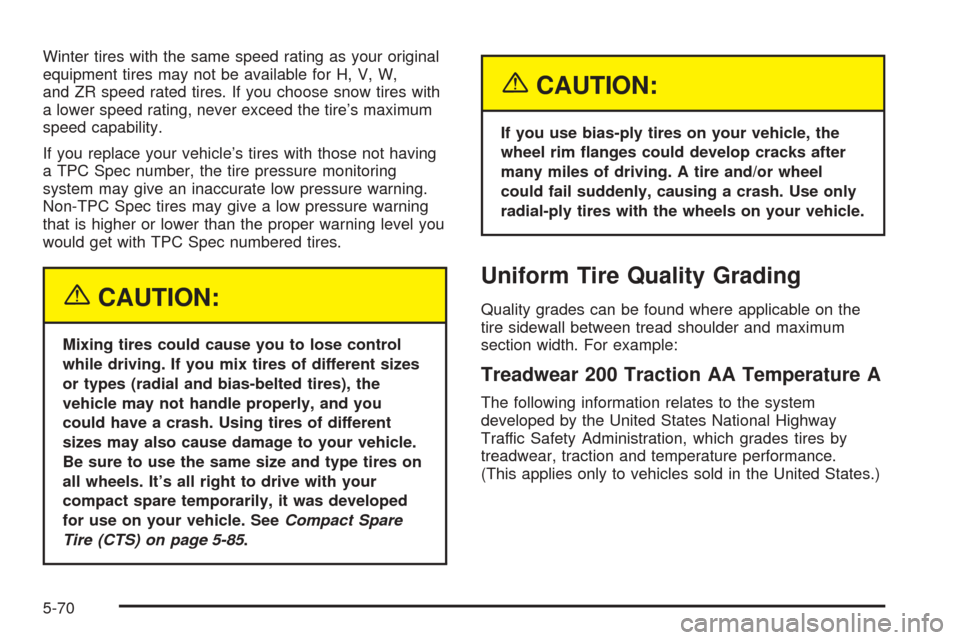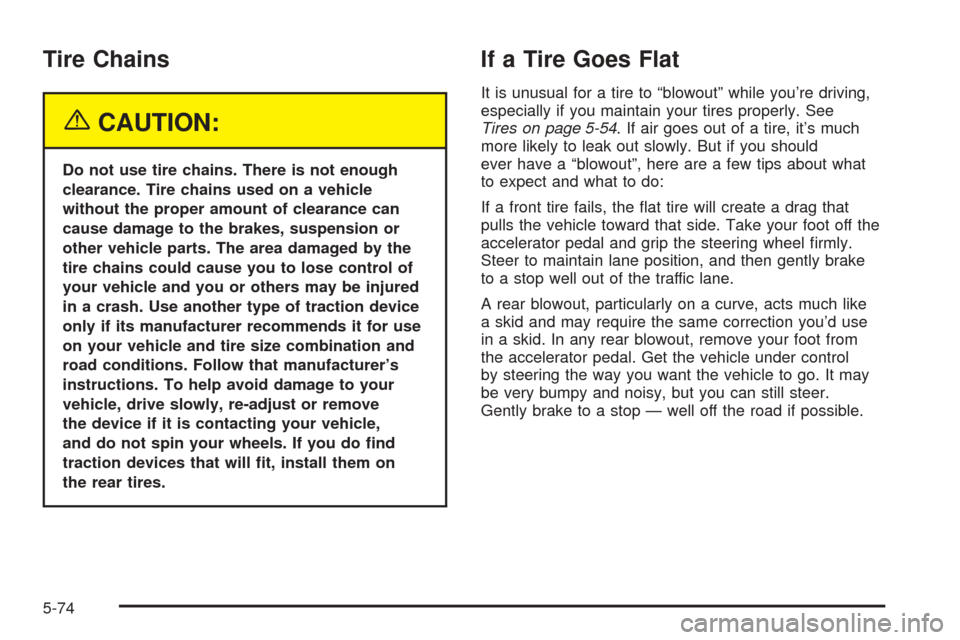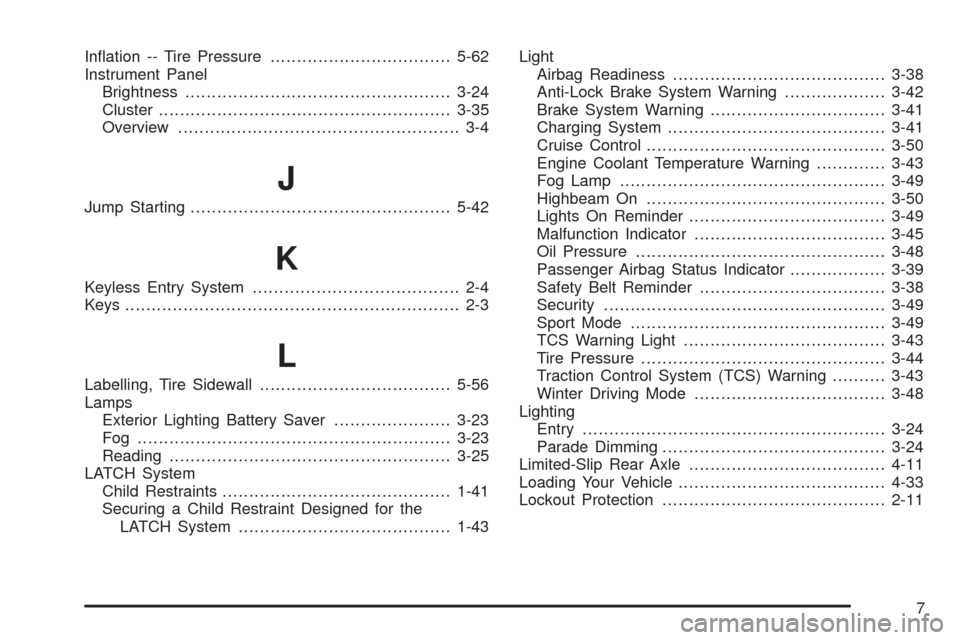traction control CADILLAC CTS V 2005 1.G Owner's Manual
[x] Cancel search | Manufacturer: CADILLAC, Model Year: 2005, Model line: CTS V, Model: CADILLAC CTS V 2005 1.GPages: 432, PDF Size: 2.52 MB
Page 267 of 432

Rocking Your Vehicle to Get It Out
First, turn your steering wheel left and right. That
will clear the area around your front wheels. You should
turn your traction control system off. SeeTraction
Control System (TCS) (CTS) on page 4-8orTraction
Control System (TCS) (CTS-V) on page 4-9. Then shift
back and forth between REVERSE (R) and a forward
gear, or with a manual transmission, between FIRST (1)
or SECOND (2) and REVERSE (R), spinning the
wheels as little as possible. Release the accelerator
pedal while you shift, and press lightly on the accelerator
pedal when the transmission is in gear. By slowly
spinning your wheels in the forward and reverse
directions, you will cause a rocking motion that may free
your vehicle. If that does not get you out after a few
tries, you may need to be towed out. If you do need to
be towed out, seeTowing Your Vehicle on page 4-38.
Loading Your Vehicle
It is very important to know how much weight your
vehicle can carry. This weight is called the vehicle
capacity weight and includes the weight of all occupants,
cargo and all nonfactory-installed options. Two labels
on your vehicle show how much weight it may properly
carry, the Tire and Loading Information label and the
Certi�cation label.
{CAUTION:
Do not load your vehicle any heavier than the
Gross Vehicle Weight Rating (GVWR), or either
the maximum front or rear Gross Axle Weight
Rating (GAWR). If you do, parts on your
vehicle can break, and it can change the way
your vehicle handles. These could cause you
to lose control and crash. Also, overloading
can shorten the life of your vehicle.
4-33
Page 350 of 432

Winter tires with the same speed rating as your original
equipment tires may not be available for H, V, W,
and ZR speed rated tires. If you choose snow tires with
a lower speed rating, never exceed the tire’s maximum
speed capability.
If you replace your vehicle’s tires with those not having
a TPC Spec number, the tire pressure monitoring
system may give an inaccurate low pressure warning.
Non-TPC Spec tires may give a low pressure warning
that is higher or lower than the proper warning level you
would get with TPC Spec numbered tires.
{CAUTION:
Mixing tires could cause you to lose control
while driving. If you mix tires of different sizes
or types (radial and bias-belted tires), the
vehicle may not handle properly, and you
could have a crash. Using tires of different
sizes may also cause damage to your vehicle.
Be sure to use the same size and type tires on
all wheels. It’s all right to drive with your
compact spare temporarily, it was developed
for use on your vehicle. SeeCompact Spare
Tire (CTS) on page 5-85.
{CAUTION:
If you use bias-ply tires on your vehicle, the
wheel rim �anges could develop cracks after
many miles of driving. A tire and/or wheel
could fail suddenly, causing a crash. Use only
radial-ply tires with the wheels on your vehicle.
Uniform Tire Quality Grading
Quality grades can be found where applicable on the
tire sidewall between tread shoulder and maximum
section width. For example:
Treadwear 200 Traction AA Temperature A
The following information relates to the system
developed by the United States National Highway
Traffic Safety Administration, which grades tires by
treadwear, traction and temperature performance.
(This applies only to vehicles sold in the United States.)
5-70
Page 351 of 432

The grades are molded on the sidewalls of most
passenger car tires. The Uniform Tire Quality Grading
system does not apply to deep tread, winter-type
snow tires, space-saver or temporary use spare tires,
tires with nominal rim diameters of 10 to 12 inches
(25 to 30 cm), or to some limited-production tires.
While the tires available on General Motors passenger
cars and light trucks may vary with respect to these
grades, they must also conform to federal safety
requirements and additional General Motors Tire
Performance Criteria (TPC) standards.
Treadwear
The treadwear grade is a comparative rating based on
the wear rate of the tire when tested under controlled
conditions on a speci�ed government test course.
For example, a tire graded 150 would wear one and
a half (1.5) times as well on the government course as
a tire graded 100. The relative performance of tires
depends upon the actual conditions of their use,
however, and may depart signi�cantly from the norm
due to variations in driving habits, service practices and
differences in road characteristics and climate.
Traction – AA, A, B, C
The traction grades, from highest to lowest, are AA, A,
B, and C. Those grades represent the tire’s ability
to stop on wet pavement as measured under controlledconditions on speci�ed government test surfaces of
asphalt and concrete. A tire marked C may have poor
traction performance. Warning: The traction grade
assigned to this tire is based on straight-ahead braking
traction tests, and does not include acceleration,
cornering, hydroplaning, or peak traction characteristics.
Temperature – A, B, C
The temperature grades are A (the highest), B, and C,
representing the tire’s resistance to the generation
of heat and its ability to dissipate heat when tested
under controlled conditions on a speci�ed indoor
laboratory test wheel. Sustained high temperature can
cause the material of the tire to degenerate and
reduce tire life, and excessive temperature can lead to
sudden tire failure. The grade C corresponds to a
level of performance which all passenger car tires must
meet under the Federal Motor Vehicle Safety Standard
No. 109. Grades B and A represent higher levels of
performance on the laboratory test wheel than the
minimum required by law.
Warning: The temperature grade for this tire is
established for a tire that is properly in�ated and not
overloaded. Excessive speed, underin�ation, or
excessive loading, either separately or in combination,
can cause heat buildup and possible tire failure.
5-71
Page 354 of 432

Tire Chains
{CAUTION:
Do not use tire chains. There is not enough
clearance. Tire chains used on a vehicle
without the proper amount of clearance can
cause damage to the brakes, suspension or
other vehicle parts. The area damaged by the
tire chains could cause you to lose control of
your vehicle and you or others may be injured
in a crash. Use another type of traction device
only if its manufacturer recommends it for use
on your vehicle and tire size combination and
road conditions. Follow that manufacturer’s
instructions. To help avoid damage to your
vehicle, drive slowly, re-adjust or remove
the device if it is contacting your vehicle,
and do not spin your wheels. If you do �nd
traction devices that will �t, install them on
the rear tires.
If a Tire Goes Flat
It is unusual for a tire to “blowout” while you’re driving,
especially if you maintain your tires properly. See
Tires on page 5-54. If air goes out of a tire, it’s much
more likely to leak out slowly. But if you should
ever have a “blowout”, here are a few tips about what
to expect and what to do:
If a front tire fails, the �at tire will create a drag that
pulls the vehicle toward that side. Take your foot off the
accelerator pedal and grip the steering wheel �rmly.
Steer to maintain lane position, and then gently brake
to a stop well out of the traffic lane.
A rear blowout, particularly on a curve, acts much like
a skid and may require the same correction you’d use
in a skid. In any rear blowout, remove your foot from
the accelerator pedal. Get the vehicle under control
by steering the way you want the vehicle to go. It may
be very bumpy and noisy, but you can still steer.
Gently brake to a stop — well off the road if possible.
5-74
Page 425 of 432

In�ation -- Tire Pressure..................................5-62
Instrument Panel
Brightness..................................................3-24
Cluster.......................................................3-35
Overview..................................................... 3-4
J
Jump Starting.................................................5-42
K
Keyless Entry System....................................... 2-4
Keys............................................................... 2-3
L
Labelling, Tire Sidewall....................................5-56
Lamps
Exterior Lighting Battery Saver......................3-23
Fog ...........................................................3-23
Reading.....................................................3-25
LATCH System
Child Restraints...........................................1-41
Securing a Child Restraint Designed for the
LATCH System........................................1-43Light
Airbag Readiness........................................3-38
Anti-Lock Brake System Warning...................3-42
Brake System Warning.................................3-41
Charging System.........................................3-41
Cruise Control.............................................3-50
Engine Coolant Temperature Warning.............3-43
Fog Lamp..................................................3-49
Highbeam On.............................................3-50
Lights On Reminder.....................................3-49
Malfunction Indicator....................................3-45
Oil Pressure...............................................3-48
Passenger Airbag Status Indicator..................3-39
Safety Belt Reminder...................................3-38
Security.....................................................3-49
Sport Mode................................................3-49
TCS Warning Light......................................3-43
Tire Pressure..............................................3-44
Traction Control System (TCS) Warning..........3-43
Winter Driving Mode....................................3-48
Lighting
Entry.........................................................3-24
Parade Dimming..........................................3-24
Limited-Slip Rear Axle.....................................4-11
Loading Your Vehicle.......................................4-33
Lockout Protection..........................................2-11
7
Page 431 of 432

Top Strap......................................................1-39
Top Strap Anchor Location...............................1-40
Towing
Recreational Vehicle.....................................4-38
Towing a Trailer..........................................4-40
Your Vehicle...............................................4-38
Traction
Control System (TCS).............................4-8, 4-9
Control System Warning Light.......................3-43
Limited-Slip Rear Axle..................................4-11
StabiliTrak
®System.....................................4-11
Transmission
Fluid, Automatic...........................................5-22
Fluid Hot Message......................................3-55
Fluid, Manual..............................................5-24
Transmission Operation, Automatic....................2-26
Transmission Operation, Manual........................2-31
Trip Odometers..............................................3-37
Trunk............................................................2-11
Turn and Lane-Change Signals.......................... 3-9
Turn Signal/Multifunction Lever........................... 3-8
U
Understanding Radio Reception.......................3-106
Uniform Tire Quality Grading............................5-70
V
Vehicle
Control........................................................ 4-5
Damage Warnings........................................... iv
Loading......................................................4-33
Parking Your...............................................2-37
Symbols......................................................... iv
Vehicle Data Collection and Event
Data Recorders............................................. 7-9
Vehicle Identi�cation
Number (VIN).............................................5-94
Service Parts Identi�cation Label...................5-95
Vehicle Personalization
DIC ...........................................................3-74
Memory Seat and Mirrors.............................2-52
Ventilation Adjustment......................................3-31
Visors...........................................................2-17
13